
 Department of Conservation and Recreation
Department of Conservation and Recreation
Conserve. Protect. Enjoy.
 Department of Conservation and Recreation
Department of Conservation and Recreation
By Dave SockyPosted October 14, 2021
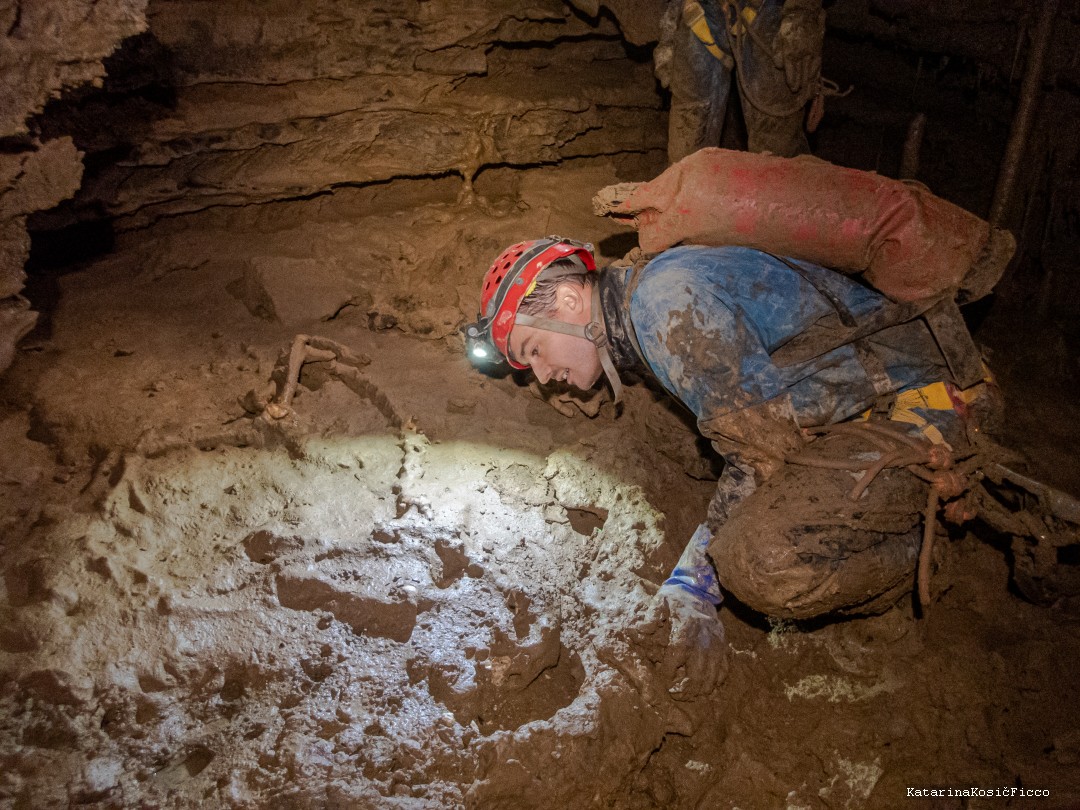
Dr. Alex Hastings inspecting the skeleton in the cave.
Burja Cave, located in Lee County, Virginia, has been explored and mapped for a number of years and is still being pushed today. It is a vertical cave and quite sporting — the good leads are three to four hours into the cave.
Before COVID hit, a large animal skeleton was discovered on one of the survey trips. Photos were taken and experts consulted. It was suspected it was some kind of cat and that it could be pretty old — thousands of years old. The skeleton was not small, about 4 feet long from head to pelvic bone.
After consultation with Dr. Alex Hastings, the Fitzpatrick Chair of Paleontology at the Science Museum of Minnesota (and the former Virginia Museum of Natural History Assistant Curator of Paleontology and a caver, of course), it was decided that the skeleton was worth collecting so that further study could take place.
In order to make the skeleton more personable and easier to discuss, Alex suggested it be given a name. Thus, it was decided to call it “Petra,” a word derived from the Greek word for rock or stone — petros.
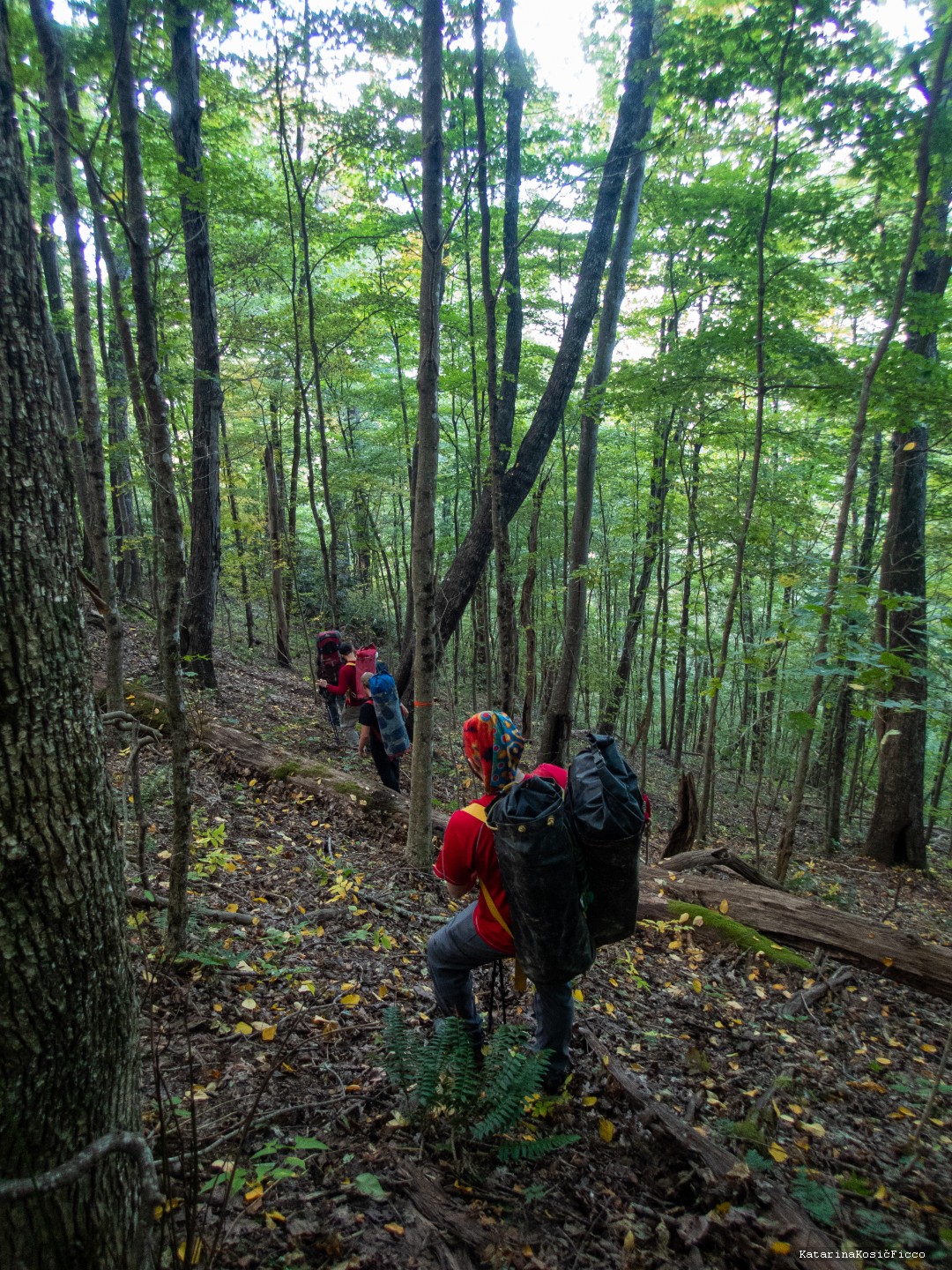 Hiking through trees to the cave.
Hiking through trees to the cave.The first date to be set for the project was in the spring of 2020, but it was cancelled due to the COVID pandemic. Finally, a new weekend was scheduled for early October, 2021. Four days were scheduled for the required work to record, excavate and remove the skeleton, starting on Thursday, Sept. 30, 2021.
Getting to the skeleton
On Thursday, a small group of cavers staged required material at the entrance to the cave. The cave is accessed by bushwhacking through the woods down a very steep mountainside for about a mile. In a couple of places there are unstable rocks covered with leaves on the steep slope, making for real tricky footing. The last 100 feet down the hill was rigged with rope to be used as a handline because of the steepness.
I arrived Thursday evening at Natural Tunnel State Park. The project had rented the largest cabin at the park since we had a total of 11 participants for the weekend. My job was to videotape the process of skeleton removal so that an educational and conservation program could be produced.
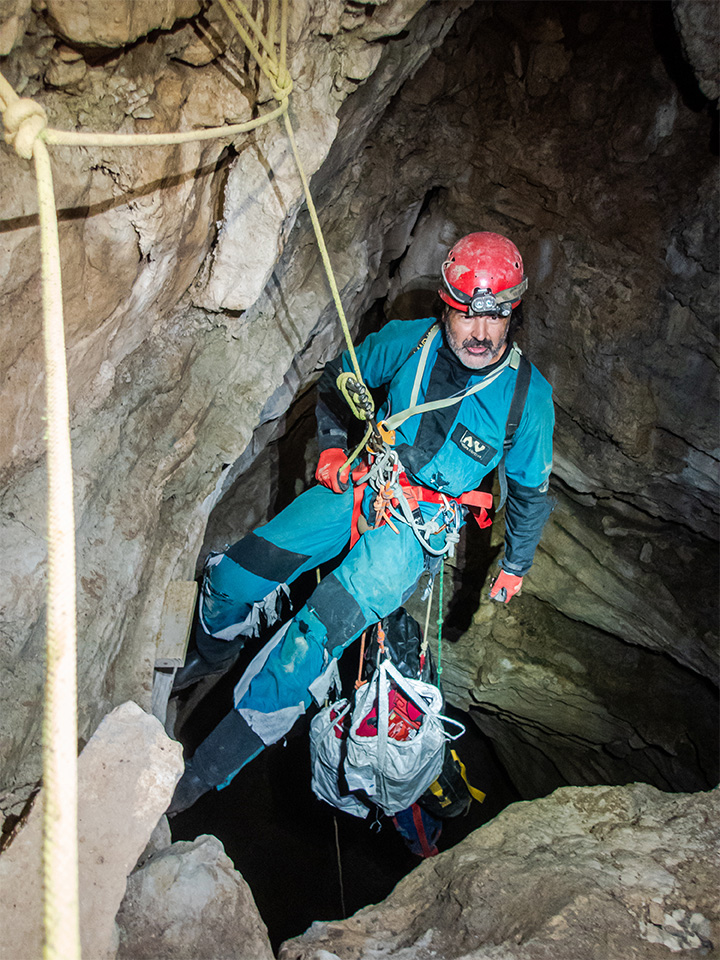
Friday morning found the group climbing down the steep mountainside with packs and backpacks of gear, plus personal cave packs and vertical kits. Twenty feet into the entrance is the first pit, a 40-foot drop into a large breakdown filled chamber. From the chamber, we went through a short, wide crawl, which turned into a narrow, muddy low tunnel with a knee-wide slot in the floor. This went on for several hundred feet but eventually opened up to almost walking passage.
The next obstacle was a section of floorless canyon with a traverse line for safety. Then another 40-foot pit into a shallow pool of water. Across the room was a 12-foot climbdown, rigged with a rope for safety. Then a nuisance drop of 15-feet and finally, after a short crawl, was the room where the skeleton was located.
With all the gear and the large number of cavers, it took about an hour to get to the site.
The real work begins
Dr. Alex Hastings was now in charge, and, after stashing our packs and removing vertical gear, we got down to work.
The first order of business was to take photos and measurements. Joe Myre took many high-resolution photos of the cat from various angles. Later, Joe will use the photos and a special computer program to construct 3D images of the skeleton.
Alex made a detailed sketch of the skeleton and wrote notes about its condition. He then performed a physical inspection to determine the condition of the skeleton. Until this time, we didn’t know whether it was composed of solid, calcified bones or if it was soft and easily broken.
If the bones were not solid, we had the material to make plaster casts.
Using dental tools to poke and prod at the bones, Alex was able to determine that the bones were very solid. As a matter of fact, they were more or less welded in place in a thin layer of calcite surrounding the skeleton.
The whole skeleton was fully articulated and was all in one piece. It would have to be broken into pieces in order for it to be removed and packaged in packs that could be carried out of the cave.
Time to dig
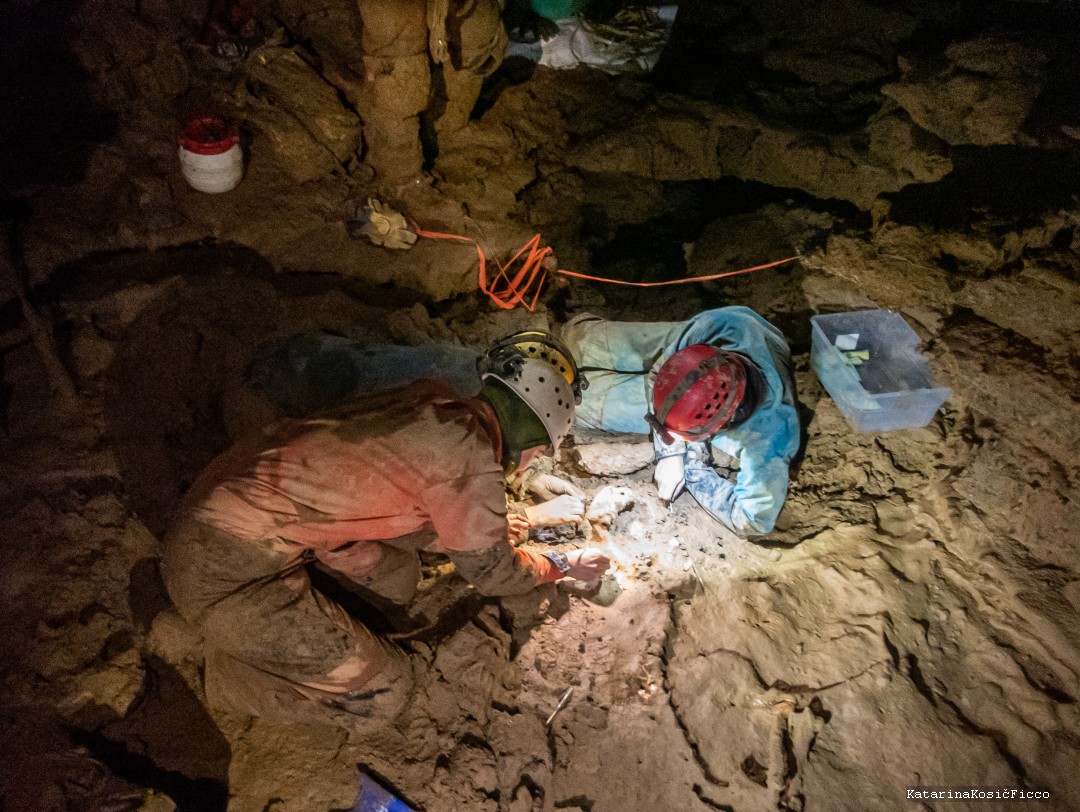
Team meticulously digging around Petra.
Once the condition of the skeleton was determined, the next task was to dig down into the rock and dirt around the bones. This task took up the better part of the whole day because it was accomplished using dental picks and small tools.
As the perimeter was dug out, dirt and rock were removed from under the bones, so that eventually the skeleton was sticking out in relief with just a little material underneath for support.
During this process, small pieces of material were dug out, at which point Alex would determine if they were bone or rock. If bone, we packaged them up in paper towels and then taped it in a sandwich of closed cell foam and bubble wrap. Each piece was marked with project name, date and location.
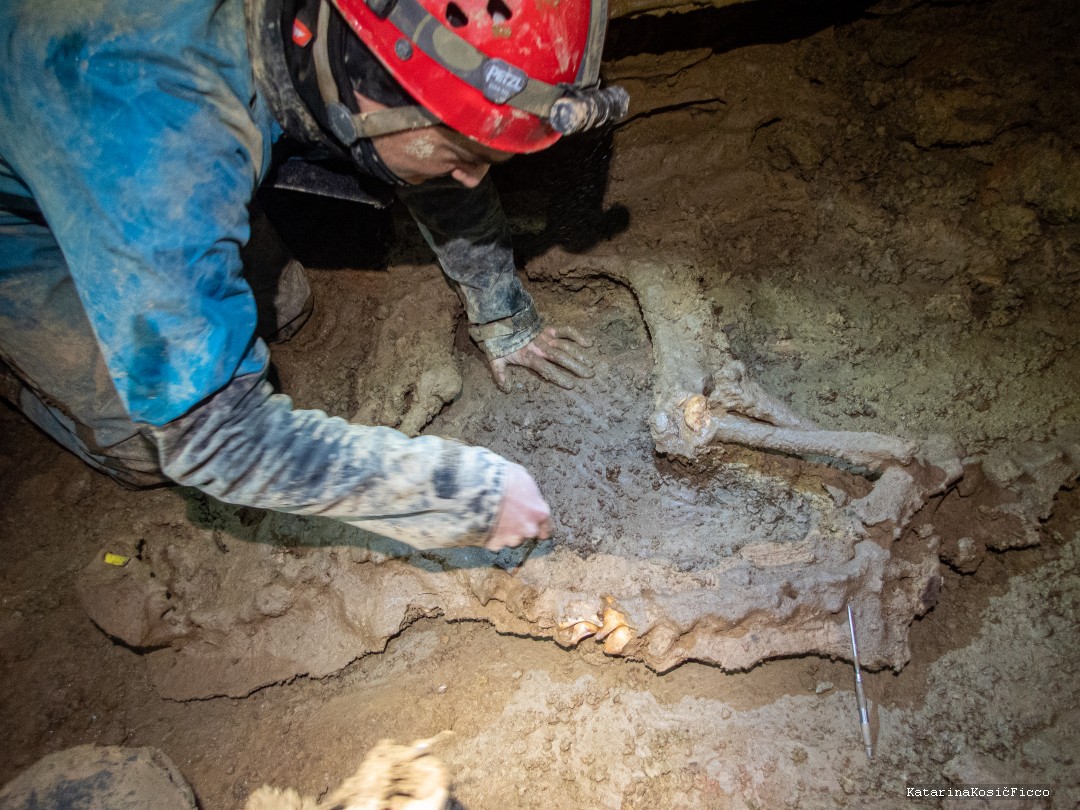
Progress after digging for hours.
After digging around and underneath, the tailbone, embedded in a thin layer of calcite, was eventually removed as one piece. It was about 2.5 feet long.
Later, the front leg bones were also detached and set aside. What was especially cool was seeing the inner section of the leg bone where it had broken off from the main skeleton. It was white, and inside the hollow section, you could see thin layers of crystalized material.
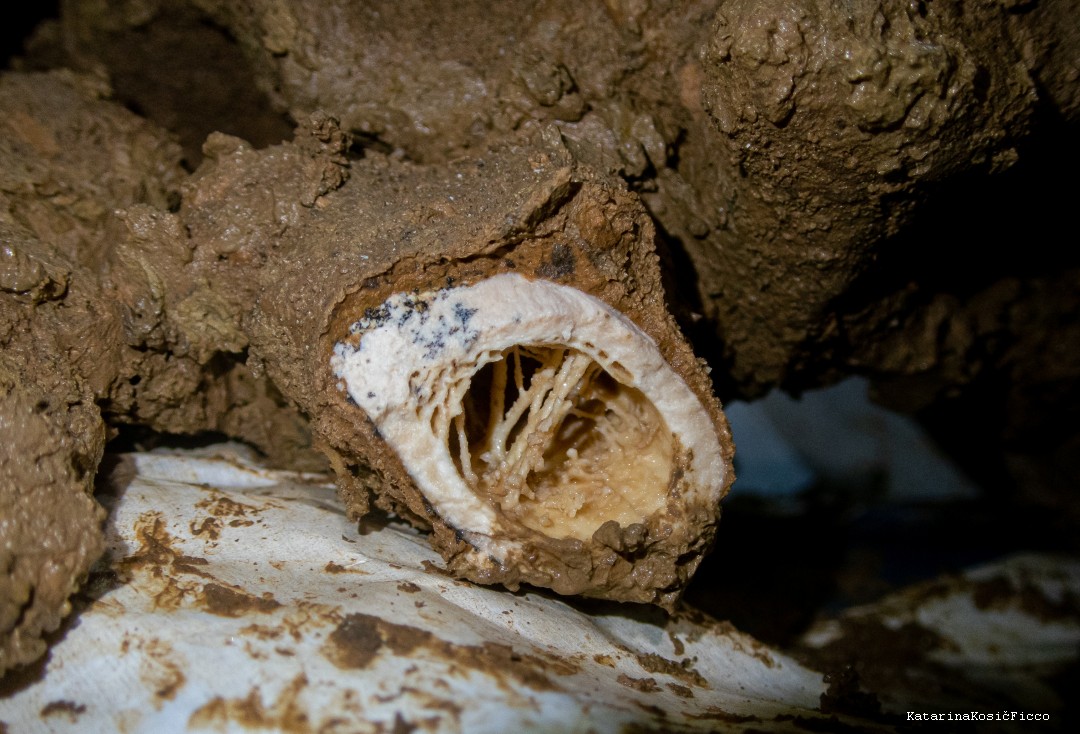
A look inside one of Petra's bone.
A long day of work
At this point, it was getting late in the day, about 6:30 p.m. We took some measurements of the tail and leg bones to see what size boxes we would need on Saturday in order to package the different parts and pieces. We then put our vertical gear back on, packed up our gear and headed out.
The location of the skeleton is not really that far from the entrance, but it is still challenging. The cave is very muddy, and the ropes get coated with mud. Our vertical gear was coated with mud.
Cams didn’t catch, so climbing out was a challenge. It took a couple of hours to get out, and then, of course, we had to climb back up the mountain in the dark.
This was my first time up this hill, and I thought it would never end. We finally made it back to the cars around 10:30 p.m.
Packing up the cat
On Saturday morning, Mike Ficco and Tom Malabad drove all the way to a Walmart to get containers, towels and bubble wrap while the rest of us headed back into the cave. The weather was great, and we made it down the mountain, into the cave and to the skeleton site without any issues.
While one group continued to dig around and under the bones, another group started in on the packaging task.
In order to protect the larger pieces, the bone was first laid on a shelf; then the upper exposed surface was covered with toilet paper. The toilet paper was sprayed with water and then molded to the surface of the bone. Another layer of toilet paper was added, sprayed and molded. More layers were added. It was kind of like a cast, where all the protruding parts were covered and protected, and the whole piece was encased in toilet paper!
The piece would then be rolled and taped in bubble wrap, and then finally encased in a thin layer of closed cell foam. Masking tape was used to hold everything together. The larger pieces were then wrapped in a thicker layer of closed cell foam (sleeping pad material from Walmart) and stuffed into large expedition cave packs.
.jpg)
(L-R) Alex Hastings, Katarina Kosic Ficco, & Lauren Satterfield wrapping a leg bone.
Some pieces, like the skull, were able to fit into large plastic containers, which were then stuffed with packing material to keep it locked in place.
One of the hardest things Alex had to contend with was deciding where and how to break parts of the skeleton. In some cases, the bones broke naturally, giving him no choice. In other cases, a hammer and chisel had to be used to force the issue. Sometimes the break would occur where desired, but in others the bone would break in unexpected locations. It had to be done, though, because there was no way the larger pieces could be moved out of the cave without damage.
The work was meticulous and time consuming, but, soon enough, all parts of the skeleton were separated and the only task remaining was to pack them with toilet paper and paper towels and surround them up with bubble wrap and package them up in packs and boxes.
At one point, we thought we might run out of toilet paper and paper towels. Mike even offered to run out of the cave and make a store run for more, but that would have taken way too long. As it turned out, we had just the right amount. We used every roll of toilet paper and paper towels and finally finished the packaging around 9 p.m.
Everyone was very happy (especially Alex) that we had gotten the whole skeleton excavated and would be able to remove all the parts and pieces from the cave that day.
Exit strategy
Now, the significant task was to remove all the packs from the cave.
Wil and Zenah Orndorff and Mike and Andrea Futrell had rigged the three drops with progress capture haul lines for pulling packs up the drops. It was decided we would haul everything up, making it easier and safer for everyone to climb out without having to tether packs. Mike and Andrea had already taken out several packs, but we still had 12 heavy mud-covered packs (some personal and some cat) to get out with only seven cavers to move them.
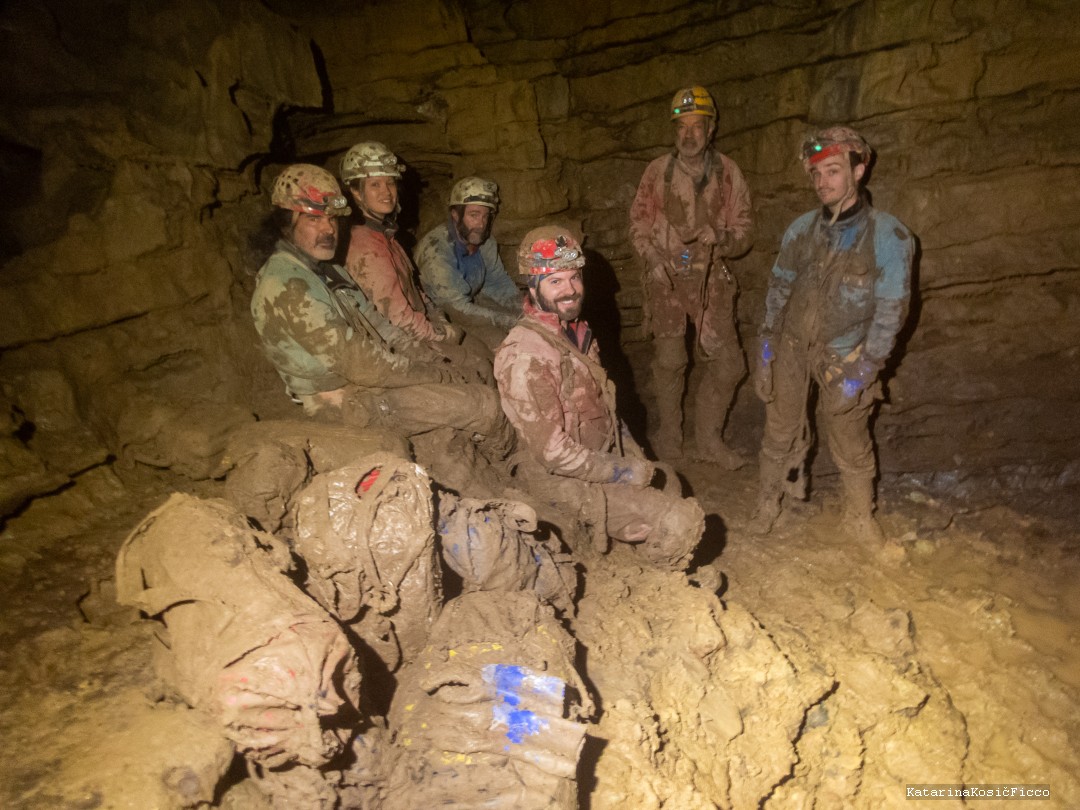
(L-R) Tom Malabad, Lauren Satterfield, Mike Ficco, Joe Myre, Dave Socky, & Alex Hastings covered in mud.
We decided to do a caver chain, where we would string out in a line and then pass packs from person to person. Once all the packs were moved to the head of the line, we would move forward past the pile and repeat the process.
We finally got all the packs piled up at the bottom of the entrance drop. I thought it was about 10 p.m., but when I looked at my watch, I saw it was 12:30 a.m.! Wow, how time flies! It was 2 a.m. when we finally got up to the cars with all the bones. Not having enough cavers, we had to leave a number of packs at the entrance to the cave to be retrieved the next day.
Sunday was pack retrieval day — in the rain. It wasn’t too bad, and by early afternoon, we had retrieved all the packs, including my “lost” chest harness and croll, which had slid down a side drop at the entrance Friday evening.
Expedition successfully complete
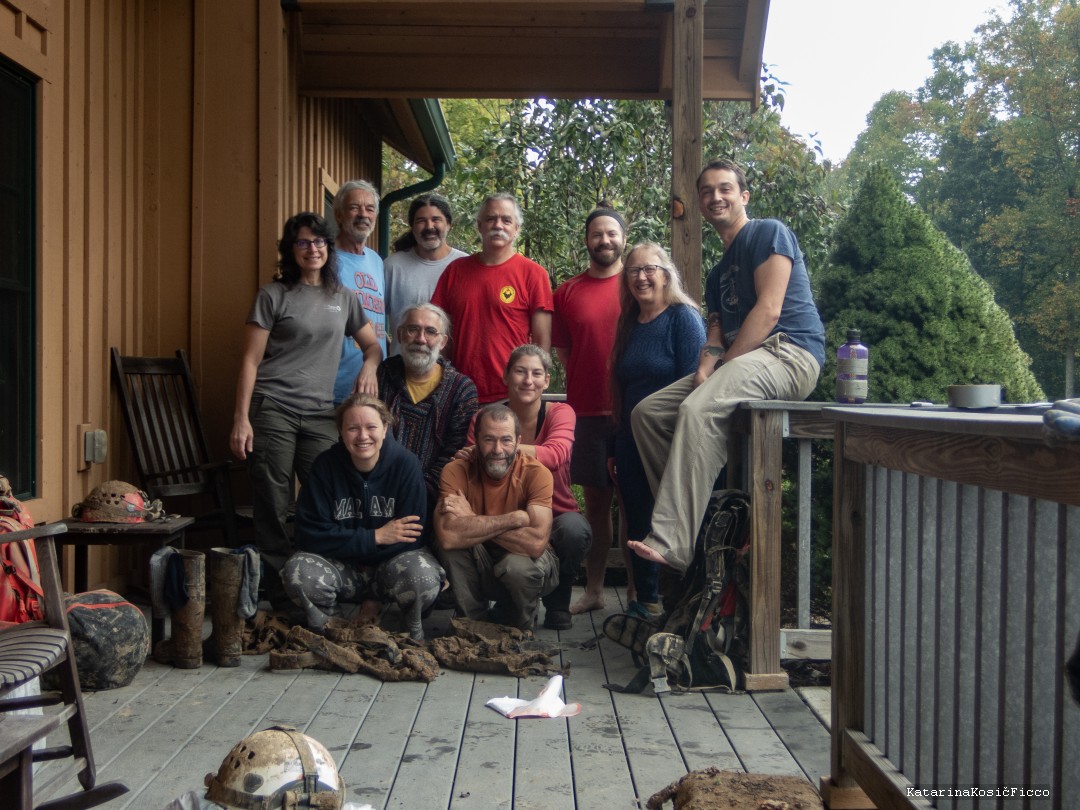
Group photo: (left to right, top to bottom) Zenah Orndorff, Dave Socky, Tom Malabad, Mike Futrell, Joe Myre, Andrea Futrell, Dr. Alex Hastings, Wil Orndorff, Katarina KosiÄ Ficco, Lauren Satterfield, Mike Ficco
It was a successful project expedition, with all the cat bones excavated and removed. Alex’s first guess is that the cat is an “American cheetah,” probably thousands of years old. However, he emphasized that this is a preliminary determination, and it's inconclusive until further studies are performed.
The Petra Project would not have been possible without the tremendous support of the Cave Conservancy of the Virginias, the Virginia Department of Conservation and Recreation Division of Natural Heritage, the Virginia Museum of Natural History, the Minnesota Science Museum, and the U.S. Forest Service.
.jpg) Dave Socky has been a project caver for 47 years. He serves as treasurer of the Blue Ridge Grotto, a member of the Board of Directors for the Cave Conservancy of the Virginias and president of the Virginia Speleological Survey.
Dave Socky has been a project caver for 47 years. He serves as treasurer of the Blue Ridge Grotto, a member of the Board of Directors for the Cave Conservancy of the Virginias and president of the Virginia Speleological Survey.
Categories
Natural Heritage
Tags
karst

